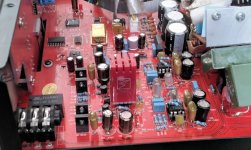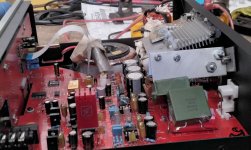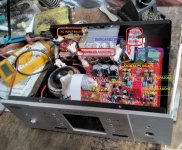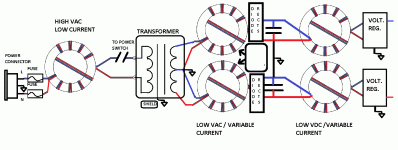Months ago I received a Kind invitation from Burson Audio to try one of its discrete opamps, the ViVid V6 which I accepted.
I am used to discrete outputs since more than a decade I use a differential JFET zero FB amplifier from -ECDesigns- on several of my DACs (including one of my main) and players, and which has a smooth, refined and ellegant sound presentation whereever I use it. In fact, since then I have not played with opamps.
But recently, having upgraded my OTARI MX5050 to its highest performance I want to improve the critical Q501 equalizer amp, a JRC2043DD if I remember correctly. Unfortunatelly, the DIP8 adaptor socket there is very worn out and I had bad luck with my programmed opamp (2043; LN4562; OPA2064; Burson) comparison....I have to solve this issue ASAP.
Fortunatelly, I have here a humble but well built SD Card Player of Chinese Origin, a HiFi360.cn machine, with two SD Card slots and which has dual PCM1794 DACs (IF I remember correctly) had a passable sound in stock version and a competent Headphone out.
Of course, it did not stay in stock version for very long....I list below the upgrades which made it a very decent (as My Mom says) player...
-Reicherts Bifilar Current Baluns on AC input (varnished with Heavy Duty Varnish), and between PS caps and Voltage Regulators, both to Digital and to Analog (on PCB bottom) sections: 4 in total.
-Replacement VRegs for teddyregs, due to space cosntraints. The Heatsinks occult the former.
-Precision Clock.
-Dedicated 5V SPDIF out, to be used as transport with Elektro-optik connection to an outboard DAC.
-Many other caps, Pana FM and Rubycon Z on the output section.
-OPA2064 in class A, 3 in total: 2 for the stereo unbalanced out and one for the Headphone out, which receives the signal from the former.
The upgraded "Baluned" Regulated supply took it to a level where I could use it as only source for a whole week during my recent holidays, using my Beyerdinamic DT990 PRO.
I chose the OPA2064 years ago as it is a good allrounder without any "outstandings" but with many "goods" and "very good", especially on bass-midbass, warmth and color presentation that make me able to listen for prolonged time without irritation and fatigue. This player is really nice in its present condition, equally able with Classical and Jazz.
I swapped the Headphone section opamp from OPA2064 to Burson Audio V6 Vivid very easilly, though I consider that the pins that come with the unit are slightly thinner than what I am acustomed to. Looked fragile to me so I was careful.
Luckily, the overall tonal balance of the Burson mirrors the one of the OPA2064, which is no surprise you might say, as this opamp receives the signal from the previous unbalanced out opamps which are indeed OPA2064 (more on that later), yes but it sounds like the OPA on steroids, and after a week or of use I confirm that this is a significant upgrade, soundwise.
For example, the string attacks on Myaskovsky's String Quartets had more definition, bite and HF harmonics and the natural melodic curves are better delineated. I have a game which is called "where is the Viola" where one has to detect the sound of this (usually) "non-solist" instrument...well, here we can not only hear but follow the Viola's contribution. The sense of the recording space is more obvious and the decays of the notes is mopre prolonged. The OPAs produce a warm tone which is welcomed with modern digital recordings of chamber music and the Burson kept that warmth but reveiled more texture and nuances in the playing.
The attacks in percussion and bronze wind intruments is also more violent, richly textured and expansive in Mombasa's African style Jazz.
The scale of the sound presentation is increased and maitains a well kept order in Shostakovich Violin Concerto°1, also in big fff tuttis. The emotional tension of the long melodic lines is contagiously expressed. Overall, the Burson opamp made me see further into the music, with much more detail and tonal richness, better painting of the curves of the musical phrases, better enjoyment of the rithmic variation. to the point I am feeling I need to upgrade my Beyerdinamics...any advise is welcome.
But all of this improvement was with the signal fed from the previous OAP2064s....today I swapped the unbalanced out for LN4562, of which I have a bunch, and to my surprise the Player sounds now only a bit more "dry" or less warm, but not cold at all, which was my reason to abandon this opamp in the first place, but more and more detail is comming out, with the tonal balance now shifted towards the medium high and high frequencies, but with deep bass and punch when needed.
For example, in Ferenc Fricsay's 1954 version of "The Rite of The Spring" one is more able to folllow several richly textured instrumental lines at a time, which was previously very difficult, and the big strikes on the Big drum are very explosive with a long decay.
In Halley Cat from Nucleus the cymballs produce an all encompassing atmosphere around the playground of the trumpet and saxo, which was previously only guessed. I am having many gestaltic moments with this new combination, digging deeper into the music.
For those who know how to build one , a discrete output is very recommended. For those who can afford one (or 3) a Burson opamp will give you a much more Vivid (pun intended) musical experience.
This is my humble opinion.
Cheers,
M.
I am used to discrete outputs since more than a decade I use a differential JFET zero FB amplifier from -ECDesigns- on several of my DACs (including one of my main) and players, and which has a smooth, refined and ellegant sound presentation whereever I use it. In fact, since then I have not played with opamps.
But recently, having upgraded my OTARI MX5050 to its highest performance I want to improve the critical Q501 equalizer amp, a JRC2043DD if I remember correctly. Unfortunatelly, the DIP8 adaptor socket there is very worn out and I had bad luck with my programmed opamp (2043; LN4562; OPA2064; Burson) comparison....I have to solve this issue ASAP.
Fortunatelly, I have here a humble but well built SD Card Player of Chinese Origin, a HiFi360.cn machine, with two SD Card slots and which has dual PCM1794 DACs (IF I remember correctly) had a passable sound in stock version and a competent Headphone out.
Of course, it did not stay in stock version for very long....I list below the upgrades which made it a very decent (as My Mom says) player...
-Reicherts Bifilar Current Baluns on AC input (varnished with Heavy Duty Varnish), and between PS caps and Voltage Regulators, both to Digital and to Analog (on PCB bottom) sections: 4 in total.
-Replacement VRegs for teddyregs, due to space cosntraints. The Heatsinks occult the former.
-Precision Clock.
-Dedicated 5V SPDIF out, to be used as transport with Elektro-optik connection to an outboard DAC.
-Many other caps, Pana FM and Rubycon Z on the output section.
-OPA2064 in class A, 3 in total: 2 for the stereo unbalanced out and one for the Headphone out, which receives the signal from the former.
The upgraded "Baluned" Regulated supply took it to a level where I could use it as only source for a whole week during my recent holidays, using my Beyerdinamic DT990 PRO.
I chose the OPA2064 years ago as it is a good allrounder without any "outstandings" but with many "goods" and "very good", especially on bass-midbass, warmth and color presentation that make me able to listen for prolonged time without irritation and fatigue. This player is really nice in its present condition, equally able with Classical and Jazz.
I swapped the Headphone section opamp from OPA2064 to Burson Audio V6 Vivid very easilly, though I consider that the pins that come with the unit are slightly thinner than what I am acustomed to. Looked fragile to me so I was careful.
Luckily, the overall tonal balance of the Burson mirrors the one of the OPA2064, which is no surprise you might say, as this opamp receives the signal from the previous unbalanced out opamps which are indeed OPA2064 (more on that later), yes but it sounds like the OPA on steroids, and after a week or of use I confirm that this is a significant upgrade, soundwise.
For example, the string attacks on Myaskovsky's String Quartets had more definition, bite and HF harmonics and the natural melodic curves are better delineated. I have a game which is called "where is the Viola" where one has to detect the sound of this (usually) "non-solist" instrument...well, here we can not only hear but follow the Viola's contribution. The sense of the recording space is more obvious and the decays of the notes is mopre prolonged. The OPAs produce a warm tone which is welcomed with modern digital recordings of chamber music and the Burson kept that warmth but reveiled more texture and nuances in the playing.
The attacks in percussion and bronze wind intruments is also more violent, richly textured and expansive in Mombasa's African style Jazz.
The scale of the sound presentation is increased and maitains a well kept order in Shostakovich Violin Concerto°1, also in big fff tuttis. The emotional tension of the long melodic lines is contagiously expressed. Overall, the Burson opamp made me see further into the music, with much more detail and tonal richness, better painting of the curves of the musical phrases, better enjoyment of the rithmic variation. to the point I am feeling I need to upgrade my Beyerdinamics...any advise is welcome.
But all of this improvement was with the signal fed from the previous OAP2064s....today I swapped the unbalanced out for LN4562, of which I have a bunch, and to my surprise the Player sounds now only a bit more "dry" or less warm, but not cold at all, which was my reason to abandon this opamp in the first place, but more and more detail is comming out, with the tonal balance now shifted towards the medium high and high frequencies, but with deep bass and punch when needed.
For example, in Ferenc Fricsay's 1954 version of "The Rite of The Spring" one is more able to folllow several richly textured instrumental lines at a time, which was previously very difficult, and the big strikes on the Big drum are very explosive with a long decay.
In Halley Cat from Nucleus the cymballs produce an all encompassing atmosphere around the playground of the trumpet and saxo, which was previously only guessed. I am having many gestaltic moments with this new combination, digging deeper into the music.
For those who know how to build one , a discrete output is very recommended. For those who can afford one (or 3) a Burson opamp will give you a much more Vivid (pun intended) musical experience.
This is my humble opinion.
Cheers,
M.
Attachments
Last edited:
I tweaked / changed quite often coupling capacitors, added Cs like described in the data sheet to voltage regulators or changed op amps for better ones.
Always with sonic benefits. Alone the difference in sound concerning power decoupling of amplifier chips showed me that there is potential for diy work on the sound.
There are so many Hifi enthusiasts swapping their solid state equipment until they find the sound they desire. If they would know how different the one piece of Hifi gear could sound depending on what the designer had his hands on constructing it (or not) they won't believe it.
Higher level is then measurement assisted work like the guy here in the forum did it making a Hifi classic like an old Rotel amp better in distortion specs by 20db without cutting traces. Liked a lot to read about that.
Always with sonic benefits. Alone the difference in sound concerning power decoupling of amplifier chips showed me that there is potential for diy work on the sound.
There are so many Hifi enthusiasts swapping their solid state equipment until they find the sound they desire. If they would know how different the one piece of Hifi gear could sound depending on what the designer had his hands on constructing it (or not) they won't believe it.
Higher level is then measurement assisted work like the guy here in the forum did it making a Hifi classic like an old Rotel amp better in distortion specs by 20db without cutting traces. Liked a lot to read about that.
Thanks very much for your input.
I did not mention that I also paralleled a 280nF Polystyrene Russian Military surplus cap (the green box at the lower right corner of the last picture) to the stock unbalanced output cap. It looks awful but sounds great.
These Polystyrene caps are very good and affordable for this task. I use them a lot.
I did not explain fully my present aproach to the power suply: it is a modified CLC, with the L being a Bifilar winding Reisert Current Balun that treats obviously the power rail but also treats the Ground current, which IMHO deals with both common and differential mode noise.... Now that I have a High Temperature- High Voltage varnish, there will be no safety concerns from the part of our distinguished coleagues.
Edit: I attached a pic with description of parts. As I said, the Baluns for the analog supply are on the bottom side of the PCB, well protected.
Edit 2: I found one conceptual diagram of the said power supply. Here, the baluns for the TX secondary windings are not fitted....
Cheers,
M.
I did not mention that I also paralleled a 280nF Polystyrene Russian Military surplus cap (the green box at the lower right corner of the last picture) to the stock unbalanced output cap. It looks awful but sounds great.
These Polystyrene caps are very good and affordable for this task. I use them a lot.
I did not explain fully my present aproach to the power suply: it is a modified CLC, with the L being a Bifilar winding Reisert Current Balun that treats obviously the power rail but also treats the Ground current, which IMHO deals with both common and differential mode noise.... Now that I have a High Temperature- High Voltage varnish, there will be no safety concerns from the part of our distinguished coleagues.
Edit: I attached a pic with description of parts. As I said, the Baluns for the analog supply are on the bottom side of the PCB, well protected.
Edit 2: I found one conceptual diagram of the said power supply. Here, the baluns for the TX secondary windings are not fitted....
Cheers,
M.
Attachments
Last edited:
Guys, I made a mistake in the description of the player, due to the fact that I use a Dammar Varnish plus Graphite powder on top of the DACs and Processors and I no longer can read the maker...and I did not write it down....sorry.
I am reading a description of the player on a dealer's site: "DAC in some parts adopt American CIRRUS top DAC chips: CS4398+CS8406+CS8416."
https://www.goldsupplier.com/provide/p125747659.html
Sorry for the mistake.
M.
a humble but well built SD Card Player of Chinese Origin, a HiFi360.cn machine, with two SD Card slots and which has dual PCM1794 DACs (IF I remember correctly)
I am reading a description of the player on a dealer's site: "DAC in some parts adopt American CIRRUS top DAC chips: CS4398+CS8406+CS8416."
https://www.goldsupplier.com/provide/p125747659.html
Sorry for the mistake.
M.
You do a lot of mods. But you can achieve already a lot with little investment.
Not many people do not know that even pro gear or more expensive Hifi equipment sometimes miss something simple like Cs between legs of voltage regs (78xx, 79xx).
Already this single tweak changes completely the sound of a Dac or CD player.
Not many people do not know that even pro gear or more expensive Hifi equipment sometimes miss something simple like Cs between legs of voltage regs (78xx, 79xx).
Already this single tweak changes completely the sound of a Dac or CD player.
Thanks for your reply.
As I stated before, this players has its stock VRegs changed for TEDDYREGs, discretes Voltage Regulators designed by Teddy Pardo. I have other special type of VRegs but they are larger so they do not fit in the limited space of this player. If you look carefully, you will see on the last picture I uploaded the bottom side of the two PCBs of the ones marked as "TEDDYREGS ANALOG", meaning the VRegs for the analog output section, and the side of the "TEDDYREG DIGITAL" for the PS of the digital section, all secured though big heatsinks to chassis.
Teddy Pardo has other VRges. If you are not aquainted with his work, here is a link:
https://teddypardo.com/product-category/diy/
Cheers,
M.
PS: As you mentioned, today I am upgrading for a friend a very well made Rotel CD player with HDCD capability and all that, which has indeed JRC7815/7915 for the output section....
As I stated before, this players has its stock VRegs changed for TEDDYREGs, discretes Voltage Regulators designed by Teddy Pardo. I have other special type of VRegs but they are larger so they do not fit in the limited space of this player. If you look carefully, you will see on the last picture I uploaded the bottom side of the two PCBs of the ones marked as "TEDDYREGS ANALOG", meaning the VRegs for the analog output section, and the side of the "TEDDYREG DIGITAL" for the PS of the digital section, all secured though big heatsinks to chassis.
Teddy Pardo has other VRges. If you are not aquainted with his work, here is a link:
https://teddypardo.com/product-category/diy/
Cheers,
M.
PS: As you mentioned, today I am upgrading for a friend a very well made Rotel CD player with HDCD capability and all that, which has indeed JRC7815/7915 for the output section....
The link I posted before has the interesting DIY articles on a spot difficult to detect.
Here is are some direct links to Pink Fish Media articles:
https://pinkfishmedia.net/forum/threads/the-best-regulator-ive-built-so-far.36174/
https://pinkfishmedia.net/forum/threads/howto-teddyreg.39990/
I am not saying they are the best. They are very good and reliable and fit to a relatively small PCB.
Cheers,
M,.
Here is are some direct links to Pink Fish Media articles:
https://pinkfishmedia.net/forum/threads/the-best-regulator-ive-built-so-far.36174/
https://pinkfishmedia.net/forum/threads/howto-teddyreg.39990/
I am not saying they are the best. They are very good and reliable and fit to a relatively small PCB.
Cheers,
M,.
I measured one - its good certainly, but its not that good, and the power consumption is high - you get better devices for far less money from standard sources - you have fallen into the trap of doing Burson's marketing for them (*) for free. Suggest you try the much cheaper OPA1656 next (or OPA1642 or ADA4625 or OPA1612 or NE5534A etc etc) and see you don't need to splash lots of money for an excellent opamp. Also IIRC the Burson's aren't even rated for +/-18V (which si going to catch some people out!)For those who know how to build one , a discrete output is very recommended. For those who can afford one (or 3) a Burson opamp will give you a much more Vivid (pun intended) musical experience.
This is my humble opinion.
Cheers,
M.
(*) They don't seem to be bothered about writing a proper datasheet for any of their devices - they must be making a killing by having shills do their marketing for them and not even spending the money to characterize the things robustly. For all we know they are made from the cheapest components they can source - no detailed measurements in a datasheet to compare with, so how could you be sure?
Last edited:
Thank you, dear Mark, for your reply.
Everything is Experience for the Soul.
You decided to Measure, then decided to Share your Experience.
I was Offered it, I decided to Try it, then I decided to Share my Experience.
I found the Experience to be Satisfactory.
Satisfaction, IMHO, is one of the goals of this hobby.
I find Satisfaction (sometimes) by Doing It Myself and then listening to it....I have Never found Satisfaction after measuring anything....
Cheers,
M.
Everything is Experience for the Soul.
You decided to Measure, then decided to Share your Experience.
I was Offered it, I decided to Try it, then I decided to Share my Experience.
I found the Experience to be Satisfactory.
Satisfaction, IMHO, is one of the goals of this hobby.
I find Satisfaction (sometimes) by Doing It Myself and then listening to it....I have Never found Satisfaction after measuring anything....
Cheers,
M.
I was just wondering about that. Modern op amps are incredible and looking at pictures of these Burson things it seems that for extra money you mainly get extra parasitics. Do you still have the measurements and can post them, so I'm not stuck with my bias?I measured one - its good certainly, but its not that good, and the power consumption is high - you get better devices for far less money from standard sources
- Home
- Source & Line
- Digital Source
- SD Card Player gets a Burson Audio Opamp




